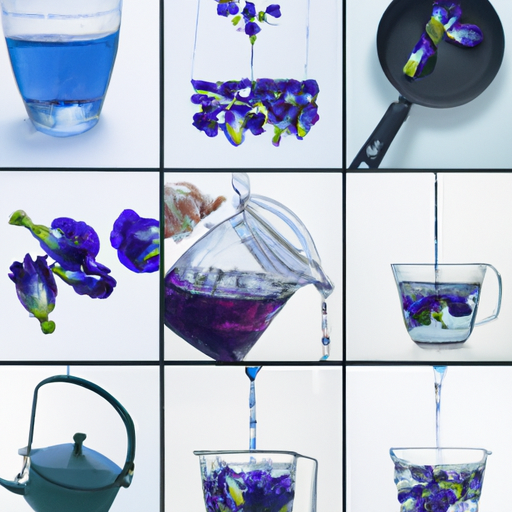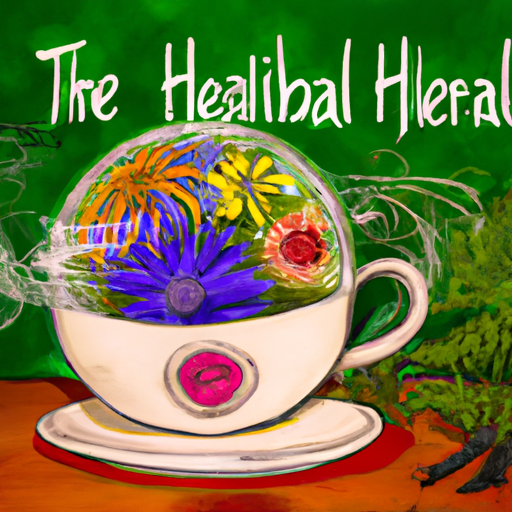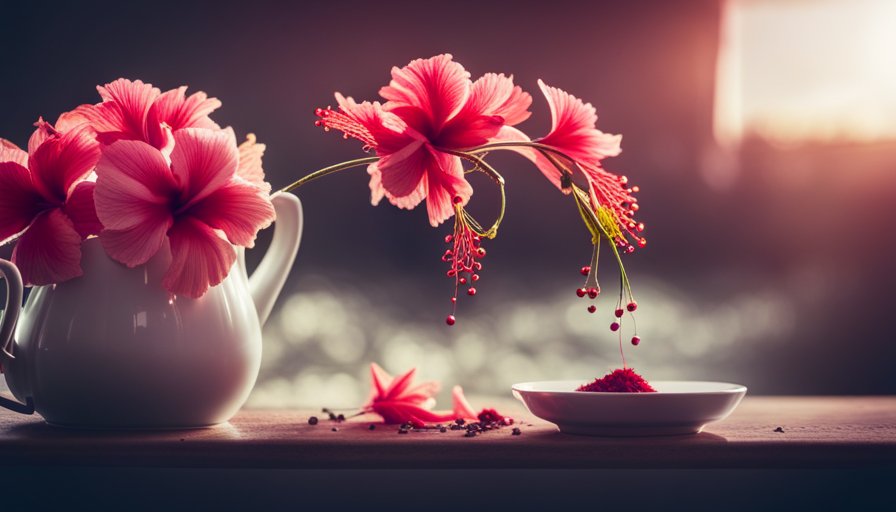Imagine stepping into a vibrant, ethereal garden, where delicate blue flowers sway gracefully in the breeze, their petals shimmering with a mesmerizing hue. These are the blue pea flowers, also known as butterfly pea flowers, and they hold a secret within their enchanting beauty.
From these flowers, a tea is crafted, a drink that not only delights the senses but also offers a myriad of health benefits. As an herbalist, I have delved into the world of blue pea flower tea, exploring its botanical classification, physical characteristics, and chemical composition. With meticulous precision, I have uncovered the secrets to preparing this tea, from sourcing the highest quality blue pea flowers to brewing techniques that extract the optimal flavors and properties.
In this article, I will share with you the step-by-step process of preparing blue pea flower tea, guided by scientific knowledge and research. So join me on this journey as we unlock the wonders of blue pea flower tea and discover the art of its preparation.
Key Takeaways
- Blue pea flower tea is made by steeping dried blue pea flowers in hot water for 5-10 minutes.
- The tea has numerous health benefits due to the presence of anthocyanins, flavonoids, and other beneficial compounds.
- Blue pea flower tea can help reduce stress, improve cognitive function, and promote healthy digestion.
- It is important to source sustainable and organic blue pea flowers for quality tea.
Introduction to Blue Pea Flower Tea
Before we dive into the magical world of blue pea flower tea, let’s explore its intriguing origins and delightful benefits.
Blue pea flower tea, also known as butterfly pea flower tea, has a rich history that dates back centuries. It’s been used in traditional medicine practices in various cultures, including Ayurveda and Traditional Chinese Medicine.
The blue pea flower, scientifically known as Clitoria ternatea, is a perennial plant that belongs to the Fabaceae family. It’s characterized by its vibrant blue petals and delicate shape. The flowers contain anthocyanins, flavonoids, and other beneficial compounds that contribute to its medicinal properties.
To prepare blue pea flower tea, start by boiling water. Add a handful of dried blue pea flowers into a teapot or cup. Pour the hot water over the flowers and let them steep for about 5-10 minutes. The longer you steep, the stronger the color and flavor of the tea. You can also enhance the taste by adding honey or lemon.
Understanding the health benefits of blue pea flower tea will be discussed in the next section, where we’ll explore its antioxidant properties and potential uses in promoting overall well-being.
Understanding the Health Benefits of Blue Pea Flower Tea
Exploring the health benefits of this vibrant infusion will transport you to a world of wellness and vitality. Blue pea flower tea, derived from the Clitoria ternatea plant, is renowned for its numerous medicinal properties. This unique flower belongs to the family Fabaceae and is characterized by its vibrant blue petals and a distinct shape resembling a woman’s genitalia.
The chemical composition of blue pea flower tea includes flavonoids, anthocyanins, and tannins, which contribute to its antioxidant and anti-inflammatory properties. Scientific research has shown that the tea can help alleviate stress, improve cognitive function, and promote healthy digestion.
Moreover, blue pea flower tea holds cultural significance in various parts of the world. In Southeast Asia, it has been used for centuries in traditional medicine and culinary practices. Its vibrant blue color makes it a popular ingredient in traditional desserts and beverages. In some cultures, the tea is believed to enhance vitality and is consumed as a natural remedy for anxiety and depression.
Understanding the medicinal properties and cultural significance of blue pea flower tea provides valuable insights into its usage and benefits. In the subsequent section, we’ll explore how to source and select quality blue pea flowers, ensuring the best possible tea experience.
Sourcing and Selecting Quality Blue Pea Flowers
To ensure you experience the best possible infusion, imagine yourself standing in a lush garden, carefully selecting vibrant blue petals from the Clitoria ternatea plant. The blue pea flower, also known as butterfly pea or Asian pigeonwings, belongs to the Fabaceae family and is native to Southeast Asia. It is a climbing vine with delicate, trumpet-shaped flowers that are a deep shade of blue. The flowers contain various bioactive compounds, including anthocyanins, flavonoids, and alkaloids, which contribute to its vibrant hue and health benefits.
When sourcing blue pea flowers for tea, it is important to find sustainable sources that prioritize organic farming practices. This ensures that the flowers are free from harmful pesticides and chemicals. After harvesting, the flowers should be dried and preserved properly to maintain their quality and potency. This can be done by gently removing the petals from the flowers and laying them out in a single layer to air dry. Once completely dry, store the petals in an airtight container away from direct sunlight.
Now that you have sourced and preserved your blue pea flowers, the next step is to prepare the tea leaves for brewing.
Preparing the Tea Leaves for Brewing
Once you’ve sourced and preserved those vibrant petals, it’s time to get those tea leaves ready for brewing. Blue pea flowers, scientifically known as Clitoria ternatea, belong to the family Fabaceae. These flowers are known for their striking blue color and delicate shape. Blue pea flowers contain various bioactive compounds such as flavonoids, anthocyanins, and alkaloids, which contribute to their health benefits.
To prepare the tea leaves, follow these steps:
-
Measure out the desired amount of dried blue pea flowers. A general guideline is 2 teaspoons of flowers per cup of water.
-
Rinse the flowers with cold water to remove any impurities.
-
Gently crush the flowers to release their flavor and aroma. Be careful not to crush them too finely, as this may result in a bitter taste.
-
Place the crushed flowers in a teapot or infuser, and add hot water. The water temperature should be around 190°F (90°C).
-
Allow the flowers to steep for about 5-7 minutes to extract the maximum flavor and beneficial compounds.
Once the tea leaves are prepared, it’s time to explore the various brewing methods for blue pea flower tea. Transitioning to the next section, let’s delve into the different techniques that can enhance your tea-drinking experience.
Brewing Methods for Blue Pea Flower Tea
Utilizing different techniques, one can elevate their tea-drinking experience by experimenting with various brewing methods for the vibrant blue pea flower infusion. Blue pea flower tea, derived from the Clitoria ternatea plant, is known for its stunning blue hue and numerous health benefits.
To prepare this tea, start by steeping the dried flowers in hot water. The recommended steeping time is around 5 to 10 minutes, but it can be adjusted according to personal preference. For a stronger flavor, steep for a longer duration.
Another brewing method involves cold brewing, which requires soaking the flowers in cold water for several hours or overnight. This method yields a lighter and more delicate flavor profile. Alternatively, you can try adding the flowers directly to boiling water and letting them simmer for a few minutes. This method creates a stronger and more concentrated infusion.
Each brewing technique offers a unique flavor profile, allowing you to explore the diverse taste spectrum of blue pea flower tea. Experiment with different steeping times and temperatures to find your preferred brewing method. Enhancing the flavor of blue pea flower tea can be achieved through various methods, such as adding citrus fruits or sweeteners.
Transitioning into the subsequent section, we’ll delve into the different ways to enhance the natural flavors of this enchanting tea.
Enhancing the Flavor of Blue Pea Flower Tea
To truly elevate the flavors of blue pea flower tea, there are a few simple techniques that can be implemented. One way to enhance the taste is by adding natural sweeteners that complement the earthy and floral notes of the tea. This can be achieved by incorporating ingredients such as honey, stevia, or even a touch of maple syrup. These natural sweeteners not only add a hint of sweetness but also balance out any bitterness that may be present.
To give you an idea of the possibilities, I have prepared a table below showcasing different natural sweeteners that pair well with blue pea flower tea:
| Natural Sweetener | Flavor Profile |
|---|---|
| Honey | Rich and floral |
| Stevia | Sweet and herbaceous |
| Maple Syrup | Earthy and caramel |
By experimenting with these sweeteners, you can create a unique and customized flavor profile that suits your taste preferences. Once you have added your desired sweetener, simply stir it into the brewed blue pea flower tea until it dissolves completely.
Now that we have enhanced the taste of the tea, let’s move on to the next section and explore how to serve and truly enjoy the delightful blue pea flower tea experience.
Serving and Enjoying Blue Pea Flower Tea
When it comes to serving and enjoying Blue Pea Flower Tea, there are a variety of options to explore. One of the key points to consider is the different variations of hot tea that can be made using this unique flower.
Additionally, there are also various iced tea variations that can be created, perfect for a refreshing and cooling drink during the warmer months. Whether you prefer a warm cup of Blue Pea Flower Tea or a chilled glass of iced tea, there are plenty of ways to savor and appreciate the flavors and benefits of this beautiful herbal beverage.
Hot Tea Variations
For a twist on your classic hot tea, try steeping blue pea flowers in boiling water for a vibrant and refreshing brew. Blue pea flowers, scientifically known as Clitoria ternatea, are native to Southeast Asia and are widely used for their medicinal properties. These beautiful flowers have a deep blue hue and a mild, earthy flavor.
To prepare blue pea flower tea, start by boiling water to different temperatures depending on the desired strength of the tea. Then, add a handful of blue pea flowers to the hot water and let them steep for 5-10 minutes. Strain the tea and enjoy it as is or experiment with herbal tea blends for added flavor.
Blue pea flower tea is known for its antioxidant properties and potential health benefits such as reducing stress and promoting digestion.
Now, let’s explore some exciting variations of iced tea using blue pea flowers.
Iced Tea Variations
Now that we’ve explored the different variations of hot tea, let’s move on to the refreshing world of iced tea. One unique way to enjoy blue pea flower tea is by preparing it as a flavored iced tea. Blue pea flower tea can be infused with various flavors such as lemon, mint, or honey, creating a delightful and refreshing beverage perfect for hot summer days.
Another creative way to use blue pea flower tea is by incorporating it into tea-infused cocktails. Its vibrant blue color adds a stunning visual appeal to cocktails, making them a hit at parties or gatherings. Whether you prefer a non-alcoholic iced tea or a boozy tea cocktail, blue pea flower tea provides a flavorful and visually appealing option.
Now, let’s move on to the next section and learn about storing blue pea flower tea.
Storing Blue Pea Flower Tea
To keep your Blue Pea Flower Tea fresh, store it in an airtight container. This will help preserve its freshness and extend its shelf life.
Here are some tips to ensure your tea stays at its best:
- Keep the tea away from direct sunlight and heat, as they can degrade the quality of the tea.
- Store the tea in a cool and dry place, such as a pantry or cupboard.
- Avoid exposing the tea to moisture, as it can lead to mold or spoilage.
- Consider using a vacuum-sealed container to further protect the tea from air and humidity.
- Label the container with the date of storage to keep track of its freshness.
Blue pea flowers, scientifically known as Clitoria ternatea, are vibrant blue flowers that belong to the Fabaceae family. They have a unique shape, resembling a butterfly, and are known for their rich anthocyanin content. Anthocyanins are natural pigments that give the flowers their blue color and also possess antioxidant properties.
Now that you know how to store your Blue Pea Flower Tea properly, let’s explore its culinary uses and discover the delightful flavors it can bring to your dishes.
Exploring Culinary Uses for Blue Pea Flower Tea
Let’s delve into the world of culinary possibilities with this vibrant and flavorful infusion. Blue pea flower tea, with its beautiful indigo hue, offers not only a visual feast but also a range of culinary techniques to explore.
The blue pea flower is a tropical plant that belongs to the Fabaceae family. Its physical characteristics include delicate petals that are a deep blue color, and its chemical composition contains flavonoids, anthocyanins, and antioxidants. To prepare the tea, start by boiling water and adding a handful of dried blue pea flowers. Let steep for 5-10 minutes, then strain and enjoy.
In terms of culinary applications, blue pea flower tea can be used as a natural food coloring agent to add a pop of color to various dishes and beverages. It can be used to make vibrant blue cocktails, colorful smoothie bowls, or even to dye rice or pasta for an eye-catching presentation. Additionally, the tea can be infused into syrups, sauces, and desserts to impart a subtle floral flavor.
Pairing blue pea flower tea with ingredients like lemon, ginger, or lemongrass can enhance its taste and create a refreshing beverage. The floral notes of the tea also pair well with tropical fruits like pineapple or passion fruit.
Blue pea flower tea offers a world of possibilities in the culinary realm. Its vibrant color and subtle flavor make it a unique ingredient to experiment with. Stay tuned for the next section where we’ll discuss the health benefits and potential uses of blue pea flower tea.
Conclusion and Final Thoughts on Blue Pea Flower Tea
Incorporating blue pea flower tea into your culinary creations can add a vibrant touch to dishes and beverages, while also providing a subtle floral flavor that pairs well with ingredients like lemon, ginger, or lemongrass. This unique tea not only adds visual appeal but also offers numerous health benefits.
Blue pea flowers, scientifically known as Clitoria ternatea, belong to the family Fabaceae. They are native to Southeast Asia and are recognized for their stunning indigo-blue petals. These flowers contain natural compounds such as anthocyanins, flavonoids, and antioxidants, which contribute to their vibrant hue and potential health benefits.
To prepare blue pea flower tea, start by boiling water and adding a handful of dried blue pea flowers. Let it steep for about 10 minutes until the water turns a deep blue color. You can adjust the intensity of the tea by adding more or fewer flowers. Once steeped, strain the tea and it’s ready to be enjoyed.
Final Thoughts: Blue pea flower tea is not only visually appealing but also offers potential health benefits. Its subtle floral flavor adds a unique touch to various culinary creations. Incorporating this tea into your diet can be a delightful and healthy choice.
Frequently Asked Questions
How long does blue pea flower tea stay fresh after brewing?
The shelf life of blue pea flower tea after brewing is typically around 2-3 days if it’s stored properly. To maintain its freshness, it’s important to store the tea in an airtight container in a cool, dry place away from direct sunlight. Additionally, avoid using wet spoons or cups when scooping or pouring the tea to prevent moisture from compromising its quality. Following these storage tips will help prolong the freshness of your blue pea flower tea.
Can blue pea flower tea be consumed hot and cold?
Hot or cold, blue pea flower tea can be enjoyed in both ways, each offering its own unique benefits. When consumed hot, the tea provides a soothing and comforting experience, perfect for relaxation and stress relief. It also aids digestion and promotes better sleep.
On the other hand, when consumed cold, blue pea flower tea becomes a refreshing and invigorating beverage, ideal for hot summer days. It helps with hydration and provides a boost of antioxidants.
In summary, blue pea flower tea can be consumed hot or cold, and each temperature offers its own set of benefits.
Are there any potential side effects or precautions to consider when drinking blue pea flower tea?
When drinking blue pea flower tea, it’s important to be aware of potential side effects and take necessary precautions. While it’s generally safe, some individuals may experience allergic reactions. It’s recommended to start with a small dosage and gradually increase if tolerated well. The tea can be consumed 1-2 times a day.
Before incorporating blue pea flower tea into your routine, it’s advised to consult with a healthcare professional, especially if you have any underlying medical conditions or are taking medications.
Can blue pea flower tea be mixed with other types of tea or herbs for added flavor?
Mixing blue pea flower tea with other types of tea or herbs can enhance its flavor and provide additional health benefits. By combining blue pea flower tea with aromatic herbs like lavender or chamomile, you can create a soothing blend that calms the mind and promotes relaxation. Adding a hint of citrus, such as lemon or orange peel, infuses the tea with a refreshing zest. Experimenting with different combinations allows you to discover unique and delightful flavors while harnessing the numerous advantages of blue pea flower tea.
Are there any specific dietary restrictions or considerations when consuming blue pea flower tea?
There are no specific dietary restrictions associated with consuming blue pea flower tea. In fact, it’s known for its numerous health benefits. Blue pea flowers are rich in antioxidants and have anti-inflammatory properties. They’re also believed to have potential cognitive and mood-enhancing effects. However, as with any herbal tea, it’s recommended to consult with a healthcare professional before incorporating it into your diet, especially if you have any underlying health conditions or are taking medications.
Conclusion
In conclusion, Blue Pea Flower Tea is a captivating beverage that not only delights the senses but also offers a plethora of health benefits. Symbolizing tranquility and serenity, the vibrant blue petals of the blue pea flower create a visually stunning brew. With its rich antioxidant content and potential medicinal properties, this tea is a true gift from nature.
By following the precise steps outlined in this article, you can unlock the full potential of the blue pea flower and experience its wonders firsthand. Embrace the beauty and wellness of Blue Pea Flower Tea today!










